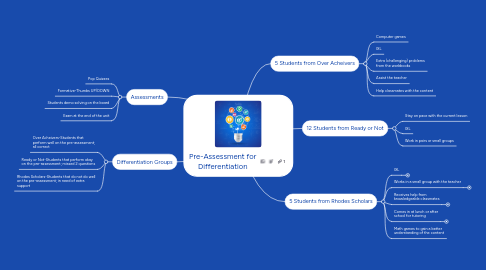
1. Differentiation Groups
1.1. Over Acheivers-Students that perform well on the pre-assessment; all correct
1.2. Ready or Not-Students that perform okay on the pre-assessment; missed 2 questions
1.3. Rhodes Scholars-Students that do not do well on the pre-assessment; in need of extra support
2. Assessments
2.1. Pop Quizzes
2.2. Formative-Thumbs UP/DOWN
2.3. Students demo solving on the board
2.4. Exam at the end of the unit
3. 5 Students from Over Acheivers
3.1. Computer games
3.2. IXL
3.3. Extra (challenging) problems from the workbooks
3.4. Assist the teacher
3.5. Help classmates with the content
4. 5 Students from Rhodes Scholars
4.1. IXL
4.1.1. Situational Analysis / Drivers
4.1.1.1. What is driving us to do this?
4.1.1.2. SWOT Analysis
4.1.1.2.1. Strengths
4.1.1.2.2. Weaknesses
4.1.1.2.3. Opportunities
4.1.1.2.4. Threats
4.1.1.3. Customer Findings - What have we learned from customers?
4.1.2. Competitive Analysis
4.1.2.1. Do we have competitors and threats in these target markets with the proposed offerings?
4.1.2.2. What are our competitors doing and how are they positioning?
4.1.2.3. How do we position against each competitor?
4.1.3. Target Customer(s)
4.1.3.1. Buyer Profile
4.1.3.1.1. Title
4.1.3.1.2. Industry
4.1.3.1.3. Geography
4.1.3.1.4. Business Size
4.1.3.2. Influencer Profile
4.1.3.3. User Profile
4.1.3.4. What do customers want and need?
4.1.3.5. What business problems do each of these customers have?
4.1.4. Customer Segmentation
4.1.4.1. Which customers or sets of customers do we sell to?
4.1.4.2. What are the target market segments that we want to go after?
4.1.4.3. What are the distinct problems for each segment of the market?
4.1.5. Total Available Market
4.1.5.1. New Prospects
4.1.5.1.1. How much of each target segment have we penetrated?
4.1.5.1.2. How much opportunity is available in each target segment?
4.1.5.2. Existing Customers
4.1.5.2.1. Can we up-sell existing customers?
4.2. Works in a small group with the teacher
4.2.1. Service Offer
4.2.1.1. What are we selling?
4.2.1.2. Product Definition
4.2.1.3. Pricing
4.2.1.4. Packaging
4.2.1.5. Positioning
4.2.2. Value Proposition
4.2.2.1. What is the Value Proposition to the Customer?
4.2.2.2. What pain are we solving?
4.3. Receives help from knowledgeable classmates
4.3.1. Revenue Forecasts
4.3.1.1. Revenue and P&L Forecast (5 Years)
4.3.1.2. Revenue should be split out quarterly
4.3.2. Cost Analysis
4.3.2.1. Should include a description of the costs in entering this business and profitability analysis
4.3.3. Profitability Analysis
4.3.3.1. P&L for the offer to include gross margin, net income and break even analysis.
4.4. Comes in at lunch or after school for tutoring
4.4.1. Sales Strategy
4.4.1.1. Direct Sales Strategy
4.4.1.2. Inside Sales Strategy
4.4.1.3. Channel Sales Strategy
4.4.2. Partner Strategy
4.4.2.1. Channel Strategy
4.4.2.1.1. What 3rd party channels should we consider for reselling this service?
4.4.2.2. Technology Partnerships
4.4.2.2.1. What technology vendors (if any) do we need to work with to execute on this plan?
4.4.2.3. Solutions Partners

